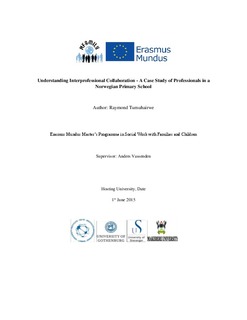| dc.description.abstract | In attempt to ensure equal education opportunities to all children, collaboration remains a fundamental best practice element of inclusive schools in Norway, usually referred to as “one school for all”. Various professionals are employed to promote equity in education.
The aim of this study was to investigate how various co-located professionals, including ordinary teachers, special needs teachers, nurses, social workers, and social educators, collaborate in an inclusive school. Among the key questions are: How do they understand and consider child participation, and how do they negotiate their professional identity from collaborative work?
I employed a qualitative descriptive case study. Using open-ended and semi-structured qualitative interview method I explored their experiences of collaborative practices and child participation, in order to gain a deeper understanding of interprofessional collaboration. I interviewed teachers, social worker, milieu therapist/special needs teacher, social educator, nurse and one school leader (Principal). The interviews with professionals showed that they were positive about interprofessionalism. They seem to share a common goal of working together to provide equal education opportunity to all children.
The processes and practices that emerged showed that professionals base their work on interprofessional values such as shared responsibility, common goals, teamwork, mutuality and flexibility. Further, I found that professionals were confident and competent about involving children to participate in all aspects that matters to them and considered equal participation opportunities. However, I noted dilemmas of fully participation of children with special needs, although this clearly varied from one child to another. Another theme that I explored, were issues of power and status differentials among teachers and teaching assistants.
Interestingly, and somewhat neglected in the existing research on interprofessionalism, the experienced of the interviewed professionals revealed the activeness of informal networks. Such networks are often ‘hidden’ in a formal system based school. It was found that lot of positive informal interactions take place among collaborating professionals in the school. | nb_NO |

